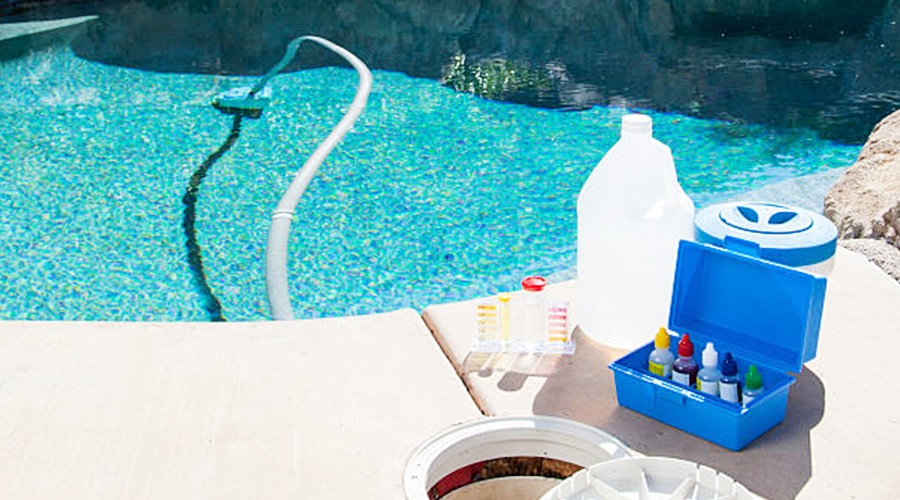What factors are related to the water quality of the swimming pool?
Several factors that can affect the water quality of a swimming pool, including:
- pH level: The pH level measures the acidity or alkalinity of the water. The ideal pH range for swimming pool water is between 7.2 and 7.8. If the pH level is too low or too high, it can cause skin and eye irritation, and can also affect the effectiveness of chlorine and other disinfectants.
- Chlorine level: Chlorine is used to disinfect the water and kill bacteria and viruses. The ideal chlorine level in a swimming pool is between 1 and 3 parts per million (ppm). If the chlorine level is too low, it can lead to algae growth and other bacterial infections. If the chlorine level is too high, it can cause skin and eye irritation.
- Total alkalinity: Total alkalinity measures the ability of the water to resist changes in pH. The ideal total alkalinity range for swimming pool water is between 80 and 120 ppm. If the total alkalinity is too low, it can cause pH fluctuations and corrosion of the pool equipment. If the total alkalinity is too high, it can lead to cloudy water and scaling.
- Calcium hardness: Calcium hardness measures the amount of dissolved calcium in the water. The ideal calcium hardness range for swimming pool water is between 200 and 400 ppm. If the calcium hardness is too low, it can cause corrosion of the pool equipment and surfaces. If the calcium hardness is too high, it can cause scaling and cloudy water.
- Total dissolved solids (TDS): TDS measures the total amount of dissolved minerals and solids in the water. The ideal TDS range for swimming pool water is between 1000 and 2000 ppm. If the TDS is too high, it can cause scaling and cloudy water.
- Cyanuric acid (CYA): CYA is a stabilizer that helps protect chlorine from being degraded by sunlight. The ideal CYA range for swimming pool water is between 30 and 50 ppm. If the CYA is too high, it can reduce the effectiveness of chlorine and lead to algae growth.
- Temperature: The temperature of the water can affect the growth of bacteria and other microorganisms. The ideal temperature range for swimming pool water is between 78 and 82 degrees Fahrenheit. If the water temperature is too high, it can promote the growth of algae and bacteria. If the water temperature is too low, it can slow down the effectiveness of chlorine and other disinfectants.
How to maintain swimming pool water quality and chemistry?
Maintaining swimming pool water quality and chemistry is essential to ensure that the pool water is safe and comfortable for swimmers. Here are some tips for maintaining swimming pool water quality and chemistry:
- Regularly test the pool water: The pH level, total alkalinity, and chlorine level should be checked at least twice a week to ensure that the pool water is balanced and safe for swimmers.
- Maintain the pH level: The pH level should be between 7.2 and 7.8 to ensure that the chlorine in the water is effective. If the pH level is too high, the chlorine becomes less effective and the water can become cloudy. If the pH level is too low, it can cause skin and eye irritation.
- Maintain the chlorine level: Chlorine is used to kill bacteria and other contaminants in the water. The ideal chlorine level is between 1 and 3 parts per million (ppm) for residential pools.
- Shock the pool: Shocking the pool with a chlorine shock treatment can help remove contaminants and algae from the water. It is recommended to shock the pool every two weeks.
- Clean the pool: Regularly clean the pool walls, floors, and skimmer baskets remove debris and contaminants from the water.
- Maintain proper water circulation: Ensure that the pool pump and filter are functioning properly to maintain proper water circulation and filtration.
- Control algae growth: Algae can cause the water to become cloudy and unsafe for swimmers. Use an algaecide to control and prevent algae growth.
- Maintain proper calcium hardness: The calcium hardness level should be between 200 and 400 ppm. Low calcium hardness can cause corrosion of metal pool parts, while high calcium hardness can cause scale buildup on the pool walls and equipment.
- Maintain proper total alkalinity: The total alkalinity level should be between 80 and 120 ppm. Low total alkalinity can cause pH fluctuations, while high total alkalinity can cause cloudy water and scaling.
By following these tips, swimming pool owners can maintain proper water quality and chemistry, ensuring a safe and enjoyable swimming experience for all.
What process control instruments are needed to monitor swimming pool water quality?
To monitor swimming pool water quality, the following process control instruments are typically needed:
- pH meter: Measures the acidity or alkalinity of the water.
- ORP meter: Measures the oxidation-reduction potential of the water, which is related to the sanitizing power of chlorine or other disinfectants.
- Chlorine analyzer: Measures the concentration of chlorine in the water.
- Total alkalinity and calcium hardness test kit: Measures the level of dissolved minerals in the water that can affect water balance and cause scaling or corrosion.
- Turbidity meter: Measures the cloudiness of the water, which can indicate the presence of particulate matter.
- Temperature sensor: Measures the water temperature, which can affect the growth of microorganisms and the effectiveness of sanitizers.
In addition to these instruments, it may also be useful to have a flow meter to measure the flow rate of water through the system and a level sensor to monitor the water level in the pool.
Why Monitoring Pool Water Quality Is Important?
Monitoring pool water quality is important for several reasons:
- Health and Safety: Pool water that is not properly maintained can lead to the growth of harmful bacteria, viruses, and other microorganisms. Swimmers can become sick or contract infections if they come into contact with contaminated water.
- Comfort: Properly maintained pool water is more comfortable to swim in. Water that is too acidic or too alkaline can cause eye and skin irritation, while water that is too warm can be uncomfortable to swim in.
- Equipment longevity: Pool equipment, such as pumps and filters, can be damaged by poorly maintained water. This can result in costly repairs or replacements.
- Aesthetics: Water that is properly balanced and maintained is clear and inviting, while water that is dirty or cloudy can be unappealing and deter swimmers.
Monitoring pool water quality is essential for ensuring a safe and enjoyable swimming experience.
Tips for Monitor Pool Water Quality and Chemistry
There are several ways to monitor pool water quality and chemistry, including:
- Test kits: There are various test kits available in the market that can help you measure the pH level, chlorine level, total alkalinity, calcium hardness, and other important parameters of pool water.
- Automated pool monitoring systems: These systems use sensors to constantly monitor and adjust the water chemistry and can alert you when certain parameters fall outside the acceptable range.
- Pool service professionals: Many pool service companies offer routine testing and maintenance services to ensure that your pool water is safe and balanced.
- Regular visual inspections: Regularly inspecting your pool for visible signs of issues, such as cloudy water, algae growth, or debris accumulation, can help you catch problems early and prevent them from becoming more serious.
All in all, maintaining proper pool water chemistry and quality requires regular monitoring, testing, and adjustment of key parameters to ensure a safe and enjoyable swimming experience.
Post time: Apr-03-2023

